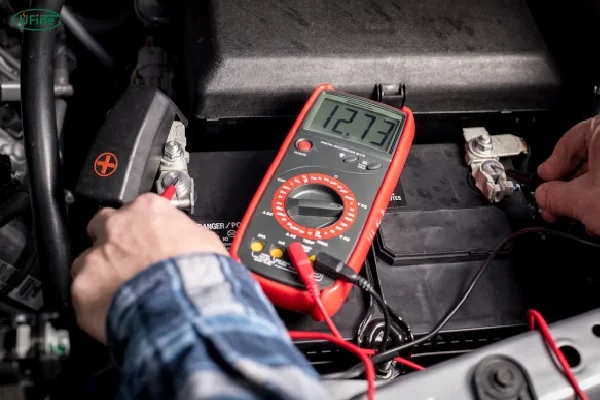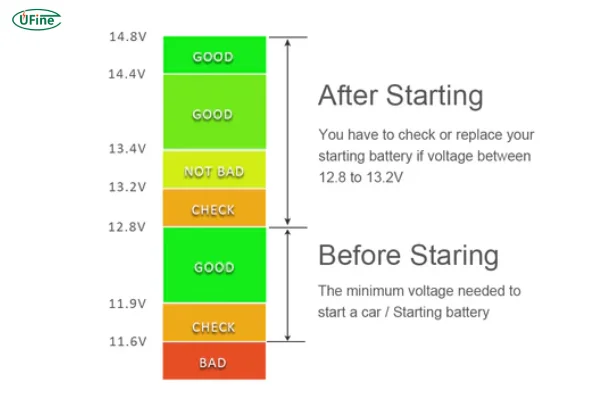When you turn the key or push the start button in your car, you expect your vehicle to come to life, smoothly and efficiently. One of the unsung heroes making that happen is the car’s battery. It’s not just about storing energy; it’s about providing the precise voltage your car’s systems need to run effectively. But have you ever wondered, what voltage is a car battery?
If you’ve asked this question, you’re not alone! Understanding your car’s battery voltage is a key part of maintaining your vehicle. In this article, we’ll delve into what voltage your car battery uses, how it affects your car’s performance, and how you can monitor and maintain it to ensure long-lasting efficiency. Let’s dive into this critical topic and explore everything you need to know!
Part 1. How does voltage affect the performance of your car?
Before we get into specifics, it’s crucial to understand how voltage impacts your car’s overall performance. Think of voltage as the “force” that drives the electrical energy through your car’s system, powering everything from the ignition system to lights and air conditioning.
When the voltage is at optimal levels, your car functions as it should: the engine starts without hesitation, your lights are bright, and your electronics work flawlessly. However, when the voltage starts to drop, the performance begins to suffer.
A 12-volt battery, which is standard in most cars, supplies electrical energy to various components. If the voltage drops below this level, you might notice issues like:
- Slower starts: Your car might take longer to crank, and the engine could feel sluggish when starting.
- Dim lights: The headlights or interior lights may appear dimmer than usual, indicating insufficient power.
- Electrical malfunction: Power-hungry electronics like air conditioning, radio, and power windows might stop working properly or exhibit intermittent failures.
As you can see, maintaining the correct voltage is essential to ensuring that your car operates smoothly. If the battery is undercharged or overcharged, it can have serious consequences on the performance and longevity of your vehicle.
Part 2. What voltage is a car battery?
Now, let’s get down to the heart of the matter: What voltage is a car battery? A typical car battery is 12 volts. This voltage rating is designed to meet the requirements of most vehicles, providing enough power to start the engine and run the electrical components.
But here’s where it gets interesting: while a car battery is nominally 12 volts, its voltage fluctuates based on its state of charge. Here’s a breakdown of the voltage at different stages:
- Fully Charged Battery: A healthy, fully charged car battery should measure between 12.6 to 12.8 volts. This is the optimal range for battery performance.
- Charging State (Engine Running): When the engine is running, the alternator charges the battery, and the voltage can rise to anywhere between 13.7 to 14.7 volts. This higher voltage is necessary to power your car’s electrical systems and recharge the battery.
- Undercharged or Low Battery: If the voltage drops below 12 volts, it could be an indicator of a problem. A battery that reads 11.8 volts or less may be nearing the end of its life or may need to be recharged immediately.
This fluctuation is a natural part of how a car battery works, and it’s important to understand these ranges so you can keep an eye on the health of your battery.
Part 3. How to check your car battery voltage?
Monitoring your car battery’s voltage is simple and can save you from unexpected breakdowns. There are several ways to check the battery voltage, and each method can give you valuable insights into its health.
-
Using a Multimeter: One of the most effective ways to check your battery’s voltage is by using a digital multimeter. It’s an affordable tool that measures electrical voltage. Simply set it to DC voltage, connect the red probe to the positive terminal of the battery, and the black probe to the negative terminal. A healthy battery should show a voltage between 12.6 and 12.8 volts when the car is off. If the engine is running, the voltage should be in the range of 13.7 to 14.7 volts.
-
Onboard Diagnostic (OBD) Tools: Many modern cars have built-in systems that can give you real-time information on battery health. Some OBD readers will provide the voltage of your car’s battery directly from your dashboard display.
-
Battery Testers: You can also purchase a dedicated car battery tester from an auto parts store. These devices are designed to provide more detailed information about not just the voltage, but also the battery’s capacity and ability to hold a charge.
Part 4. What causes the battery voltage to drop?
While a healthy car battery usually maintains its voltage levels, several factors can cause the voltage to drop. Let’s take a closer look at what can cause this problem:
-
Aging Battery: Car batteries lose their ability to retain charge as they age. Over time, the chemical reactions inside the battery slow down, leading to lower voltage and diminished capacity. Most car batteries last between 3 to 5 years, depending on the climate, driving conditions, and maintenance.
-
Electrical Drain: If your car’s electrical components, like the lights or the radio, are left on while the engine is off, they can drain the battery. This constant drain reduces the battery’s voltage, eventually leading to a dead battery.
-
Faulty Alternator: The alternator is responsible for recharging your battery while you drive. If the alternator is faulty or not working properly, it will fail to supply the necessary charge to your battery, leading to a drop in voltage.
-
Corrosion on Battery Terminals: Sometimes corrosion or loose connections at the battery terminals can cause poor contact, which can reduce the voltage. Cleaning the battery terminals regularly can help maintain a strong connection and steady voltage.
-
Cold Weather: In colder climates, a car battery can lose its charge more quickly. Cold weather thickens the chemical electrolytes inside the battery, making it harder for the battery to provide the required voltage.
Part 5. What are the signs of low battery voltage?
It’s essential to recognize the warning signs of a low battery voltage before you end up stranded. Here are a few key symptoms to watch for:
-
Dim or Flickering Headlights: One of the first signs of low voltage is dim or flickering headlights. If your headlights are much dimmer than usual, it’s a sign your battery might not be providing enough power.
-
Slow Engine Crank: If your car’s engine cranks more slowly than usual when starting, it could be an indication that the battery is struggling to deliver the necessary power.
-
Dashboard Warning Light: Most cars have a dashboard light that will illuminate when there’s an issue with the charging system or the battery. If this light comes on, it’s time to check the battery’s voltage.
-
Electrical Failures: From malfunctioning power windows to an unresponsive radio, low voltage can cause a variety of electrical systems to fail.
-
Frequent Stalling: If your car stalls while driving, it could be due to a weak battery or insufficient voltage, affecting the engine’s performance.
Part 6. Conclusion
Now that you know what voltage is a car battery and how it affects your vehicle, it’s clear that monitoring your battery’s voltage is an essential part of car maintenance. A well-maintained battery ensures that your vehicle starts without hesitation and that your electrical systems run smoothly.
If you notice any of the signs of low voltage or if your battery is nearing the end of its life, it’s crucial to address the issue quickly. Regular checks and good maintenance practices, such as cleaning battery terminals and ensuring the alternator is functioning properly, can help keep your car running efficiently for years to come.
By understanding and monitoring your car’s battery voltage, you ensure that your vehicle stays reliable, safe, and ready to hit the road whenever you are.
This revised article offers a more in-depth exploration, expanding on each point while providing thorough, easy-to-understand information. It also engages the reader emotionally by focusing on the importance of maintaining car battery voltage for a smoother driving experience.
Related Tags:
More Articles

How to Choose the Best Floor Scrubber Battery for Commercial Cleaning?
Selecting the ideal floor scrubber battery ensures a long runtime, rapid charging, and minimal maintenance for efficient commercial cleaning operations.
Battery for Blower vs Battery for Leaf Vacuum: Which One Should You Choose?
Battery for blower vs leaf vacuum—learn the key differences in power, fit, and runtime to choose the right battery for your outdoor tool needs.
How to Choose the Right Battery for Blower?
Choosing the right blower battery? Consider voltage, capacity, chemistry & usage. This guide helps match the best battery for peak performance.
How to Choose the Best Insulated Battery Box for Lithium Batteries?
Choosing the Best Insulated Battery Box for Lithium Batteries? Discover key factors such as size, material, and safety for optimal protection and performance.
7 Critical Elements on a Lithium Battery Shipping Label
What must be on a lithium battery shipping label? Learn 7 key elements to ensure safety, legal compliance, and correct handling across all transport modes.





